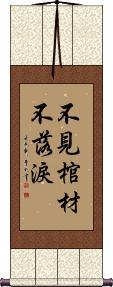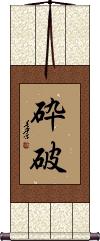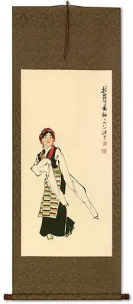Many custom options...
And formats...

Tear in Chinese / Japanese...
Buy a Tear calligraphy wall scroll here!
Personalize your custom “Tear” project by clicking the button next to your favorite “Tear” title below...
Do not shed a tear until you see the coffin
不見棺材不落淚 is a cautionary tale that suggests you are unknowingly (though it should be obvious)on a bad course.
It further suggests that you will not realize your folly until the worst has happened.
This can also be a warning of inaction until it's too late to take action. Again, not realizing your error until it's too late.
In an alternate interpretation, some will suggest this means doing something bad and not looking back - Then the worst happens.
It should be noted that this is one of the oddest selections for a wall scroll in our whole Asian calligraphy database. All of our translators are convinced that no Chinese person would ever hang this on their wall.
Saifa
砕破 is the title “Saifa” written in Japanese Kanji. This literally means “smash and tear.” Like most styles of martial arts, Saifa has origins in China. It was Higashionna that brought Saifa to Okinawa.
Saifa is generally associated with Gōjū-ryū as a title for a kata.
Notes: While Saifa is often written as 砕破, it can also be written 碎破 (just a variation on the first Kanji). Sometimes written in Japanese Katakana as サイハ.
This in-stock artwork might be what you are looking for, and ships right away...
Gallery Price: $90.00
Your Price: $35.00
Not the results for tear that you were looking for?
Below are some entries from our dictionary that may match your tear search...
| Characters If shown, 2nd row is Simp. Chinese |
Pronunciation Romanization |
Simple Dictionary Definition |
珍珠 see styles |
zhēn zhū zhen1 zhu1 chen chu chizu ちず |
More info & calligraphy: Pearl(surname) Chizu |
不見棺材不落淚 不见棺材不落泪 see styles |
bù jiàn guān cai bù luò lèi bu4 jian4 guan1 cai5 bu4 luo4 lei4 pu chien kuan ts`ai pu lo lei pu chien kuan tsai pu lo lei |
More info & calligraphy: Do not shed a tear until you see the coffin |
劈 see styles |
pǐ pi3 p`i pi heki へき |
to split in two; to divide break; tear; pierce; split; burst To split, rend, tear. |
夷 see styles |
yí yi2 i ebisu えびす |
non-Han people, esp. to the East of China; barbarians; to wipe out; to exterminate; to tear down; to raze barbarian; (surname) Ebisu transliteration of Indic i sound |
扯 see styles |
chě che3 ch`e che |
to pull; to tear; (of cloth, thread etc) to buy; to chat; to gossip; (coll.) (Tw) ridiculous; hokey |
折 see styles |
zhé zhe2 che sagari さがり |
to break; to fracture; to snap; to suffer loss; to bend; to twist; to turn; to change direction; convinced; to convert into (currency); discount; rebate; tenth (in price); classifier for theatrical scenes; to fold; accounts book (1) opportunity; chance; occasion; time; (n,ctr) (2) fold; pleat; crease; (3) small food box (wooden or cardboard); (personal name) Sagari Tear open, break down.; To snap, break; decide; compound; fold. |
拆 see styles |
chāi chai1 ch`ai chai |
to tear open; to tear down; to tear apart; to open |
捩 see styles |
liè lie4 lieh |
tear; twist |
撕 see styles |
sī si1 ssu |
to tear |
撝 㧑 see styles |
huī hui1 hui ki |
to split; to direct; to brandish; humble to tear |
撦 扯 see styles |
chě che3 ch`e che |
variant of 扯[che3]; to pull; to tear |
擘 see styles |
bò bo4 po |
thumb; to break; to tear; to pierce; to split |
攋 see styles |
là la4 la |
to destroy; to rip; to tear open |
泪 see styles |
rui るい |
(1) tear; tears; lachrymal secretion; (2) sympathy; (female given name) Rui |
涕 see styles |
tì ti4 t`i ti tei / te てい |
tears; nasal mucus (1) tear; tears; lachrymal secretion; (2) sympathy; (personal name) Tei to cry |
涙 see styles |
lèi lei4 lei rui るい |
Japanese variant of 淚|泪[lei4] (1) tear; tears; lachrymal secretion; (2) sympathy; (out-dated or obsolete kana usage) (1) tear; tears; lachrymal secretion; (2) sympathy; (female given name) Rui |
轘 see styles |
huàn huan4 huan |
to tear between chariots (as punishment) |
催涙 see styles |
sairui さいるい |
(adj-f,n) (See 催涙ガス) tear-inducing |
催淚 催泪 see styles |
cuī lèi cui1 lei4 ts`ui lei tsui lei |
to move to tears (of a story); tear-provoking (gas); lacrimogen |
切る see styles |
kiru(p); kiru(sk) きる(P); キる(sk) |
(transitive verb) (1) to cut; to cut through; to perform (surgery); (transitive verb) (2) (See 縁を切る) to sever (connections, ties); (transitive verb) (3) to turn off (e.g. the light); (transitive verb) (4) (See 電話を切る) to terminate (e.g. a conversation); to hang up (the phone); to disconnect; (transitive verb) (5) to punch (a ticket); to tear off (a stub); (transitive verb) (6) to open (something sealed); (transitive verb) (7) to start; (transitive verb) (8) to set (a limit); to do (something) in less or within a certain time; to issue (cheques, vouchers, etc.); (transitive verb) (9) (See 値切る) to reduce; to decrease; to discount; (transitive verb) (10) to shake off (water, etc.); to let drip-dry; to let drain; (transitive verb) (11) to cross; to traverse; (transitive verb) (12) to criticize sharply; (transitive verb) (13) to act decisively; to do (something noticeable); to go first; to make (certain facial expressions, in kabuki); (transitive verb) (14) (See ハンドルを切る) to turn (vehicle, steering wheel, etc.); (transitive verb) (15) to curl (a ball); to bend; to cut; (transitive verb) (16) to shuffle (cards); (transitive verb) (17) {mahj} to discard a tile; (transitive verb) (18) to dismiss; to sack; to let go; to expel; to excommunicate; (transitive verb) (19) to dig (a groove); to cut (a stencil, on a mimeograph); (transitive verb) (20) (See 切り札・1) to trump; (transitive verb) (21) {go} (sometimes キる) (See キリ・1) to cut (the connection between two groups); (transitive verb) (22) (also written as 鑽る) to start a fire (with wood-wood friction or by striking a metal against stone); (transitive verb) (23) to draw (a shape) in the air (with a sword, etc.); (suf,v5r) (24) (after the -masu stem of a verb) (See 使い切る) to do completely; to finish doing; (suf,v5r) (25) (after the -masu stem of a verb) (See 疲れ切る) to be completely ...; to be totally ...; to be terribly ...; (suf,v5r) (26) (after the -masu stem of a verb) (See 言い切る・1) to do clearly; to do decisively; to do firmly |
剥す see styles |
hegasu へがす hagasu はがす |
(irregular okurigana usage) (transitive verb) (kana only) to tear off; to peel off; to rip off; to strip off; to skin; to flay; to disrobe; to deprive of; to detach; to disconnect |
劈く see styles |
tsunzaku つんざく |
(transitive verb) (kana only) to break; to tear; to pierce; to split; to burst |
崩す see styles |
kuzusu くずす |
(transitive verb) (1) to destroy; to demolish; to pull down; to tear down; to level; (transitive verb) (2) to disturb; to put into disorder; to throw off balance; to make shaky; (transitive verb) (3) to relax (one's pose); to make oneself at ease; (transitive verb) (4) (oft. 札を崩す, etc.) to break (a bill); to change; to make change; (transitive verb) (5) (oft. as 字を崩す) to write in cursive style; to write in running style; (transitive verb) (6) (as 顔を崩す, etc.) to break into a smile; to let off a smile; (transitive verb) (7) to lower (a price) |
打掉 see styles |
dǎ diào da3 diao4 ta tiao |
to tear down; to destroy; to dismantle (a gang); to abort (a fetus) |
扯破 see styles |
chě pò che3 po4 ch`e p`o che po |
tear apart |
抓狂 see styles |
zhuā kuáng zhua1 kuang2 chua k`uang chua kuang |
(Tw) (coll.) to be driven crazy (with frustration, stress, anger etc); to tear one's hair out; to freak out |
折ぐ see styles |
hegu へぐ |
(transitive verb) to tear off; to peel off; to rip off; to strip off; to skin; to flay; to bark; to disrobe |
拆毀 拆毁 see styles |
chāi huǐ chai1 hui3 ch`ai hui chai hui |
to demolish; to tear down |
拆用 see styles |
chāi yòng chai1 yong4 ch`ai yung chai yung |
to tear down and reuse; to cannibalize |
拆除 see styles |
chāi chú chai1 chu2 ch`ai ch`u chai chu |
to tear down; to demolish; to dismantle; to remove |
Click here for more tear results from our dictionary
The following table may be helpful for those studying Chinese or Japanese...
| Title | Characters | Romaji (Romanized Japanese) | Various forms of Romanized Chinese | |
| Do not shed a tear until you see the coffin | 不見棺材不落淚 不见棺材不落泪 | bú jiàn guān cái bú luò lèi bu2 jian4 guan1 cai2 bu2 luo4 lei4 bu jian guan cai bu luo lei bujianguancaibuluolei | pu chien kuan ts`ai pu lo lei puchienkuantsaipulolei pu chien kuan tsai pu lo lei |
|
| Saifa | 砕破 | sai fa / saifa | ||
| In some entries above you will see that characters have different versions above and below a line. In these cases, the characters above the line are Traditional Chinese, while the ones below are Simplified Chinese. | ||||
Successful Chinese Character and Japanese Kanji calligraphy searches within the last few hours...






